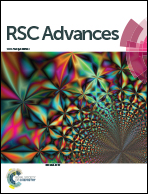In situ formation of multiple stimuli-responsive poly[(methyl vinyl ether)-alt-(maleic acid)]-based supramolecular hydrogels by inclusion complexation between cyclodextrin and azobenzene†
Abstract
Biocompatible external stimuli-responsive hydrogels are of interest for drug delivery, cell and gene therapy, tissue engineering, protein patterning, and other biomedical applications. In this work, based on the biocompatible polymer poly(methyl vinyl ether-alt-maleic acid) (P(MVE-alt-MA)), host polymer β-cyclodextrin-grafted P(MVE-alt-MA) (P(MVE-alt-MA)-g-β-CD) and guest polymer azobenzene-grafted P(MVE-alt-MA) (P(MVE-alt-MA)-g-azo) were first prepared. Then through taking advantage of the traditional host–guest interaction of β-cyclodextrin and azobenzene, novel multiple stimuli-responsive physical P(MVE-alt-MA)-g-β-CD/P(MVE-alt-MA)-g-azo supramolecular hydrogels were obtained after simply mixing the aqueous solutions of the host polymer and guest polymer. The formation of the supramolecular hydrogels was also confirmed by 2D-NOESY. This kind of supramolecular hydrogels not only exhibits photo-, pH- and thermo-sensitivity, but also cytocompatibility. Ovarian cancer SKOV3 cells can survive within different hydrogel layers, which were observed by confocal microscopy. These results suggest that this multiple stimuli-responsive P(MVE-alt-MA)-based supramolecular hydrogel may be expected to have a powerful potential in biomedical applications as a three-dimensional (3D) cell culture matrix or as a vehicle for the delivery of drugs and therapeutic cells.
![Graphical abstract: In situ formation of multiple stimuli-responsive poly[(methyl vinyl ether)-alt-(maleic acid)]-based supramolecular hydrogels by inclusion complexation between cyclodextrin and azobenzene](/en/Image/Get?imageInfo.ImageType=GA&imageInfo.ImageIdentifier.ManuscriptID=C5RA22541H&imageInfo.ImageIdentifier.Year=2016)

 Please wait while we load your content...
Please wait while we load your content...